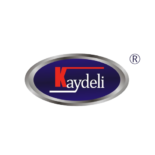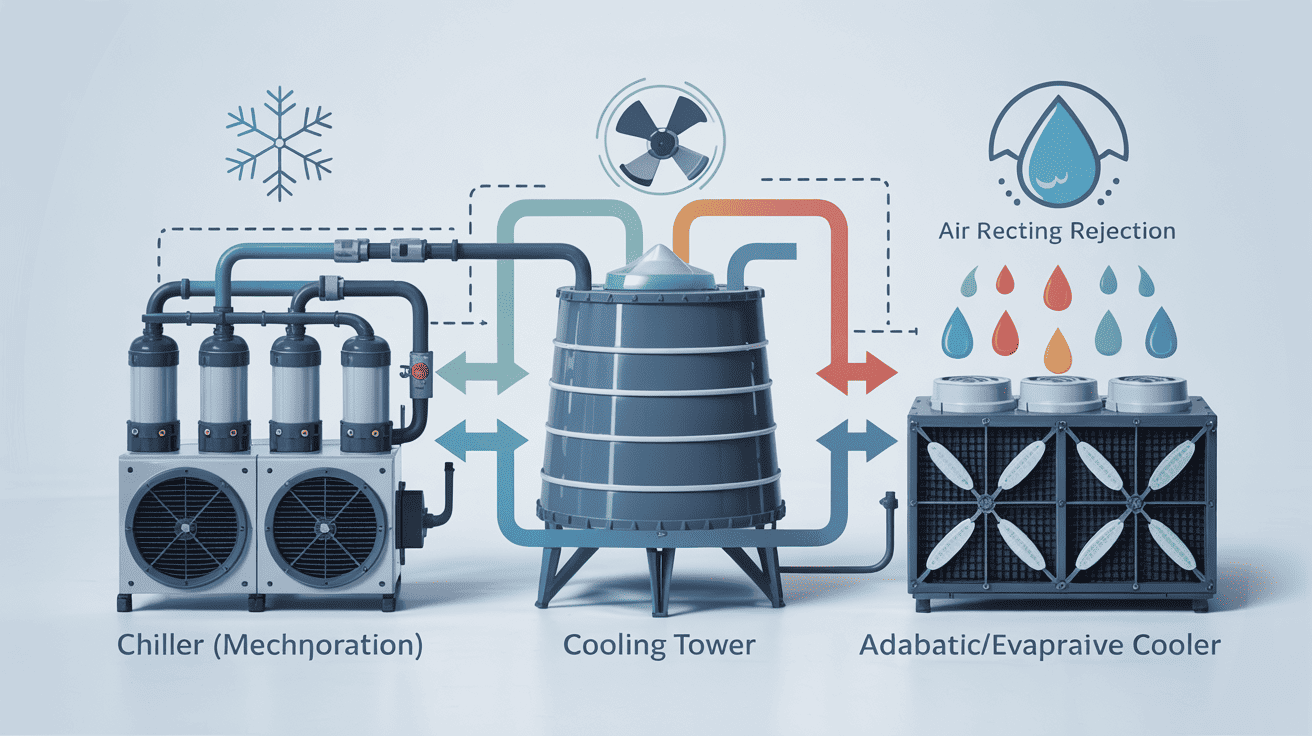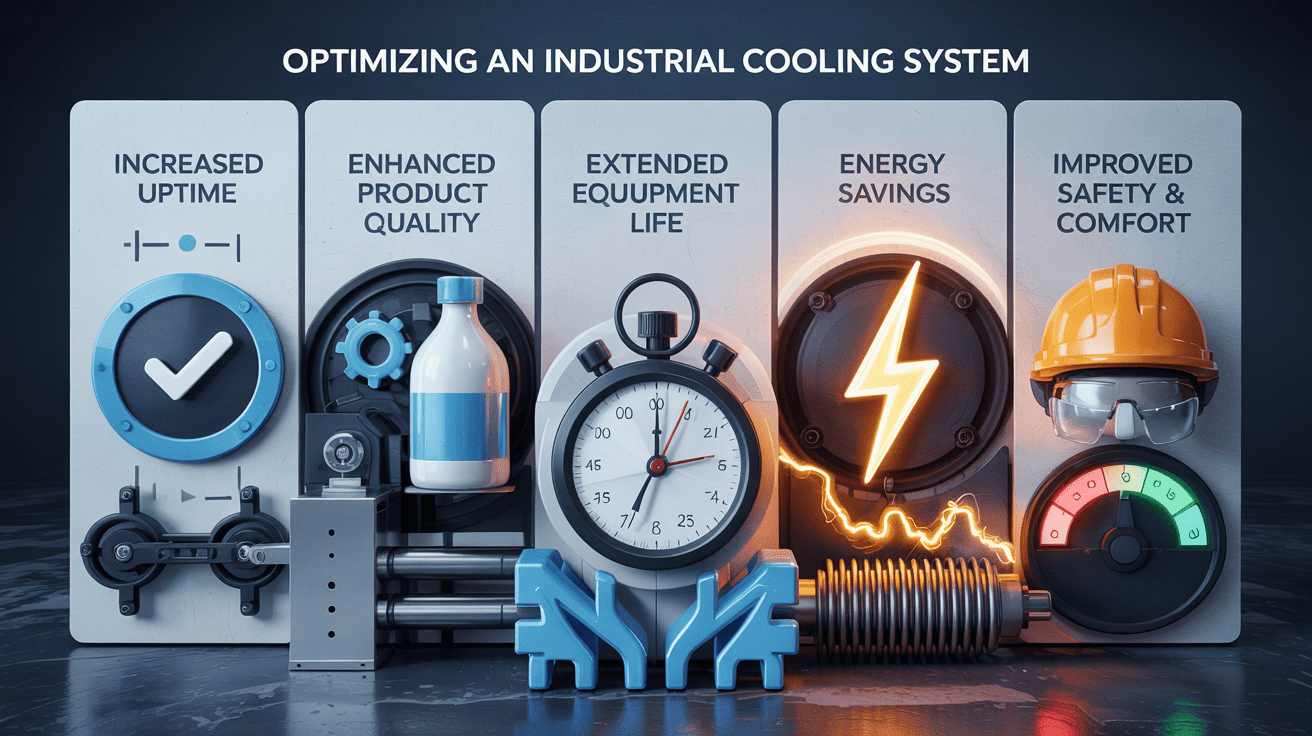Is your factory floor sweltering? Overheating equipment doesn’t just feel uncomfortable; it causes expensive shutdowns and can permanently damage vital machinery. Finding the right cooling system isn’t a luxury—it’s essential for smooth, efficient production.
Choosing the best industrial cooling solution means looking closely at your needs. You must accurately calculate your heat load, determine the precise temperature your process requires, assess available space and utilities (like water and power), and balance your budget between initial purchase and long-term operating costs. Common choices include various types of chillers, cooling towers, and evaporative or adiabatic coolers.
Picking the wrong cooling system can quickly turn into a costly mistake, leading to sky-high energy bills, inconsistent product quality, or equipment that fails prematurely. But don’t feel overwhelmed. Understanding the core options and how they match different needs makes the decision much clearer. Let’s explore these systems and how to select the perfect fit for your unique manufacturing operation.
What Types of Industrial Cooling Systems Are Available?
Feeling lost in the sea of cooling system acronyms and specifications? Choosing incorrectly can drain your budget through wasted energy and poor performance. Knowing the main types and their specific strengths is the first step toward making a wise investment for your factory.
The primary industrial cooling systems1 are chillers (using mechanical refrigeration), cooling towers (using water evaporation for heat rejection, often paired with water-cooled chillers2), and adiabatic or evaporative coolers3 (cooling air directly via water evaporation). Each technology has distinct advantages and is suited for different operational scales and precision requirements.
Let’s dive deeper into these standard cooling solutions. As the Marketing & Sales Manager at Kaydeli, I’ve guided countless clients through this selection process. It’s crucial to understand each type’s mechanics, efficiency potential, and limitations to see how it aligns with your production goals and facility constraints. Misunderstanding these basics is where costly errors often begin.
Chillers: The Workhorses of Precision Cooling
Think of chillers as industrial-strength refrigerators designed for processes, not just spaces. They use a refrigeration cycle (vapor-compression or absorption) to actively remove heat from a circulating fluid, typically water or a water-glycol mixture. This chilled fluid flows through your equipment (like molds, reactors, lasers, or servers) or processes heat exchangers, maintaining very stable and often low temperatures.
There are several variations, but the main distinction lies in how they reject the heat they absorb:
- Air-Cooled Chillers: These units use ambient air to cool the refrigerant in the condenser. Large fans blow air across condenser coils, transferring the heat directly to the surrounding atmosphere.
- Pros: Simpler installation (no cooling tower needed), lower initial cost, less water consumption. Suitable for smaller loads or where water is scarce/expensive.
- Cons: Efficiency drops significantly as ambient air temperature rises. It can be noisier due to large fans. Generally less energy-efficient than water-cooled counterparts, especially at higher capacities. Requires ample space with unobstructed airflow, often outdoors. I recall a client with a plastics molding plant in a very hot climate. [Insert brief story about initial consideration of air-cooled, challenges with summer heat derating performance, and the analysis leading to a different choice.] We had to carefully model the peak ambient conditions against the required cooling capacity to avoid production issues during the hottest months. Their required mold temperature was critical, and the potential drop in cooling capacity with an air-cooled unit was too risky.
- Water-Cooled Chillers: These use a secondary water loop, typically supplied by a cooling tower, to carry heat away from the condenser. The cooling tower then rejects this heat to the atmosphere through evaporation.
- Pros: Higher energy efficiency (often measured by COP – Coefficient of Performance, or kW/ton), especially for larger capacities (>100 tons) and in hot climates. More stable performance regardless of ambient air temperature. It can often be installed indoors, saving valuable outdoor space. Quieter operation at the chiller unit itself (tower noise is separate).
- Cons: Higher initial cost (chiller + tower + pumps + piping). Significant water consumption is required for the cooling tower. More complex installation and requires regular water treatment and tower maintenance to prevent scale, corrosion, and biological growth.
Within these categories, you also find different compressor technologies (like scroll, screw, centrifugal) impacting efficiency, capacity range, and cost. Chillers are indispensable for applications demanding precise temperature control (often +/- 1°C or better) and low temperatures (down to -40°C or even lower with specialized units), such as:
- Plastics Injection Molding & Extrusion
- Chemical & Pharmaceutical Reactors
- Laser Cutting & Welding
- MRI Machines & Medical Equipment
- Centros de dados
- Food & Beverage Processing (e.g., wort cooling, dairy)
Cooling Towers: Bulk Heat Rejection Specialists
Cooling towers are essentially large heat exchangers that use the power of evaporation to cool water. They are most commonly used with water-cooled chillers2, but can also directly cool process water if very low temperatures aren’t needed. Warm water from the process or chiller condenser is pumped to the top of the tower and distributed over a fill material, increasing the surface area. Air is drawn through the filter, causing a small portion of the water to evaporate. This evaporation cools the remaining water, which is collected in a basin and returned to the process or chiller.
Key aspects of cooling towers:
- High Heat Rejection Capacity: Excellent for dissipating large heat loads cost-effectively.
- Water Consumption: Significant water use due to evaporation, drift (water droplets carried out with the air), and blowdown (periodically draining some water to remove concentrated minerals). Water quality monitoring and chemical treatment are essential.
- Performance Factors: Efficiency depends heavily on the ambient wet-bulb temperature (a measure combining temperature and humidity). They are most effective in dry climates.
- Maintenance: Require diligent maintenance schedules for cleaning the fill and basin, checking mechanical components (fans, motors), and managing water chemistry to prevent Legionella bacteria, scale buildup, and corrosion. Neglecting maintenance severely impacts performance and safety.
Cooling towers are staples in power generation plants, large commercial HVAC systems, oil refineries, steel mills, and large-scale manufacturing facilities with substantial, continuous heat loads.
Evaporative and Adiabatic Coolers: Efficient Air Cooling
These systems use the same principle as cooling towers – cooling through water evaporation – but apply it primarily to cooling air rather than process water directly.
- Direct Evaporative Coolers (Swamp Coolers): Air is drawn through water-saturated pads (like cellulose or aspen wood). The evaporating water cools the air, which is then delivered into a space or process.
- Pros: Extremely energy efficient (uses only fan and small pump power). Low initial cost. Adds humidity, which can be good in dry climates.
- Cons: Cooling effectiveness depends entirely on ambient humidity (limited cooling in humid conditions). Adds significant moisture to the air stream, making it unsuitable for many processes or humid climates. Cannot achieve precise temperature control. It requires a water supply and periodic pad cleaning/replacement.
- Indirect Evaporative Coolers: Use a heat exchanger to cool the process air without adding moisture directly. More complex and expensive than direct coolers, but avoids the humidity issue.
- Adiabatic Coolers: Often used to pre-cool ambient air before it enters the condenser coils of an air-cooled chiller or air handling unit. Water is misted or dripped onto pads in front of the condenser intake. This lowers the incoming air temperature through evaporation, significantly boosting the efficiency and capacity of the air-cooled system, especially in hot, dry weather, without adding moisture to the primary process.
These systems are best suited for:
- Comfort cooling in dry climates in large, open spaces (warehouses, workshops).
- Pre-cooling intake air for other cooling systems to improve efficiency.
- Processes where moderate cooling is sufficient and added humidity is acceptable or desired.
Here’s an expanded comparison table:
| Recurso | Air-Cooled Chiller | Water-Cooled Chiller | Cooling Tower (Standalone) | Direct Evaporative Cooler | Adiabatic System |
|---|---|---|---|---|---|
| Primary Cooling | Process Fluid (Refrig.) | Process Fluid (Refrig.) | Process Water | Air | Air (Pre-cooling) |
| Heat Rejection | Ambient Air | Cooling Tower Water | Ambient Air (Evap.) | Ambient Air (Evap.) | Ambient Air (Evap.) |
| Typical Efficiency | Moderate (Lower COP/EER) | High (Higher COP/EER) | N/A (Rejects Heat) | Very High (Low kW) | Boosts Other System Eff. |
| Temp. Control | Very Precise | Very Precise | Less Precise | Not Precise | N/A (Pre-cools) |
| Lowest Temp. | Low (e.g., -10°C) | Low (e.g., -10°C) | Near Wet-Bulb Temp | Near Wet-Bulb Temp | N/A |
| Uso da água | Nenhum | High (Tower) | Very High | Moderado | Moderate (Intermittent) |
| Humidity Impact | Low | Low (Chiller), High (Tower) | High | Very High | High |
| Custo inicial | Moderado | High | Moderado | Low | Moderado |
| Operating Cost | Moderate-High (Energy) | Lower (Energy), High (Water) | Low (Energy), High (Water) | Very Low (Energy) | Low (Energy/Water) |
| Manutenção | Moderate (Coil Cleaning) | High (Tower Treatment) | High (Water Treatment) | Moderate (Pads/Water) | Moderate (Pads/Nozzles) |
Understanding these nuances is vital. The next step involves matching these capabilities to the specific demands of your factory.
How Do You Choose the Best Cooling System for Your Specific Process?
Are you staring at spec sheets and wondering which system tits your factory floor? Making a guess or choosing based only on price can lead to chronic inefficiency, process problems, or inadequate cooling when you need it most. A methodical evaluation ensures optimal performance, reliability, and cost-effectiveness for years.
To choose the best cooling system, you must conduct a thorough analysis covering: your precise required cooling temperature and stability needs, the accurately calculated total heat load (peak and average), prevailing environmental conditions (ambient temperature, humidity, water availability/quality), physical space constraints and installation logistics, the complete budget picture (initial CapEx vs. long-term OpEx), and any unique process demands or future expansion plans.
Selecting the right industrial cooling system isn’t a simple pick-list exercise; it’s a critical engineering and financial decision. I always emphasize to my clients at Kaydeli that investing time in a detailed upfront analysis prevents costly corrective actions later. Let’s break down the essential factors you need to consider.
Factor 1: Required Temperature and Stability Needs4
This is often the first filter. What exact temperature does your process fluid or equipment need to be? And how much fluctuation can it tolerate?
- Critical Low Temperatures (e.g., below 10°C / 50°F) or High Precision (+/- 0.5°C): Chillers (air or water-cooled) are almost always the required solution. Their refrigeration cycle allows them to achieve reliably low temperatures and maintain tight control, which is essential for sensitive processes like semiconductor manufacturing, precision optics, or specific chemical reactions.
- Moderate Temperatures (e.g., 20-35°C / 68-95°F) with Less Stringent Stability: Depending on the heat load and climate, options open up. High-efficiency chillers, fluid coolers (using ambient air with coils like a radiator, but for liquid), or sometimes cooling towers paired with efficient heat exchangers might be suitable and potentially more cost-effective than a low-temp chiller.
- General Equipment/Space Cooling (Non-Critical Temps): If you need to remove bulk heat from hydraulics or cool a large workspace in a dry climate, direct evaporative coolers can offer massive energy savings, provided the added humidity is acceptable.
Factor 2: Accurate Heat Load Calculation (kW or BTU/hr)5
This is arguably the most critical calculation. How much heat, exactly, does your process generate that needs to be removed? You need the peak load (maximum heat generated during worst-case conditions) and the average load (typical operating heat).
- Undersizing: Catastrophic. The system won’t keep up, leading to process failures, equipment damage, and lost production, especially during peak demand or hot weather.
- Gross Oversizing: Wasteful. You pay more upfront for capacity you don’t need, and the system may run inefficiently at low loads (short cycling), increasing wear and tear and energy consumption. Aim for a safety margin (e.g., 10-20%), but avoid excessive oversizing.
Calculating the load accurately involves:
- Equipment Specifications: Check the manufacturer’s data for heat dissipation values.
- Process Calculations: Use thermodynamics (Q = m Cp ΔT, where Q is heat load, m is mass flow rate, Cp is specific heat, and ΔT is the temperature change required).
- Measuring: Sometimes, temporary instrumentation is needed on existing processes to get real-world data.
We often collaborate closely with client engineering teams on this. [Insert brief story about a client whose initial heat load estimate was significantly off, perhaps based only on motor nameplates without considering process energy, and how a proper calculation led to a correctly sized, more efficient system.] Getting this number right is non-negotiable for success.
Factor 3: Environmental and Utility Conditions
Your plant’s location and available utilities heavily influence the best choice:
- Ambient Air Temperature (Design High/Average): Directly impacts air-cooled chiller performance (higher temps = lower capacity/efficiency) and the effectiveness of all evaporative processes (towers, evaporative/adiabatic coolers). Water-cooled chillers are less affected by air temp if the cooling tower is appropriately sized for the local wet-bulb temperature.
- Ambient Humidity / Wet-Bulb Temperature: Crucial for cooling towers and evaporative/adiabatic systems. High humidity drastically reduces their cooling potential. Check historical weather data for your location’s design wet-bulb temperature.
- Water Availability, Cost, and Quality: Essential for water-cooled chillers and cooling towers. Is water readily available? What is the cost per gallon/liter? What is the water quality (hardness, chlorides, biologicals)? Poor water quality necessitates more complex and costly water treatment systems to prevent scaling, corrosion, and health hazards (like Legionella). Air-cooled or closed-loop systems become more attractive if water is scarce or expensive.
- Power Availability and Cost: What is the available voltage/phase? What is the cost per kWh? This impacts operating cost calculations, especially comparing high-efficiency water-cooled systems vs. potentially lower-efficiency air-cooled ones.
Factor 4: Space, Installation, and Infrastructure
Where will the system physically go?
- Footprint & Location: Air-cooled chillers need outdoor space or large, well-ventilated indoor areas with good airflow. Water-cooled chillers can often go indoors (mechanical room) but need space for pumps, piping, and the external cooling tower. Towers need significant outdoor space, structural support (often a roof), and distance from air intakes.
- Installation Complexity: Air-cooled units are generally simpler. Water-cooled systems involve extensive piping for both the chilled water loop and the condenser water loop to the tower. Consider rigging, piping, electrical connections, and potential building modifications costs.
- Noise Considerations: Are there nearby offices or residential areas? Cooling towers and air-cooled condensers can generate significant noise. Check local ordinances and manufacturer noise data.
Factor 5: Total Cost of Ownership (TCO)6
Look beyond the sticker price:
- Capital Expenditure (CapEx): Initial purchase price of the equipment, plus installation, rigging, piping, electrical, and commissioning costs. Typically lower for evaporative coolers and air-cooled chillers, higher for water-cooled systems with towers.
- Operating Expenditure (OpEx): Ongoing costs including:
- Energy: Electricity consumption (chiller compressors, pumps, fans). Often, the most significant component. Compare efficiency ratings (COP, EER, IPLV) carefully.
- Water: Makeup water for cooling towers, evaporative coolers, and sewer costs.
- Maintenance: Routine checks, cleaning (coils, pads, tower fill/basin), water treatment chemicals, filter changes, potential repairs. Water-cooled systems generally have higher maintenance needs.
- Consumables: Water treatment chemicals, replacement pads for evaporative coolers.
Calculate the TCO over the expected system lifespan (e.g., 10-15 years). A lower CapEx system might have a much higher TCO due to poor energy efficiency or high maintenance.
Factor 6: Specific Process Needs & Future Plans
Any unique requirements?
- Redundancy (N+1, N+2): Is cooling critical with no downtime allowed (e.g., data center, critical medical)? You may need redundant units or capacity.
- Material Compatibility: Ensure coolant fluids and system materials are compatible with your process.
- Scalability/Modularity: Do you anticipate future growth? Modular chillers allow you to add capacity incrementally. Planning pipe sizes and space for future expansion can save costs later.
- Environmental Regulations: Are there restrictions on refrigerant types (e.g., GWP limits) or water discharge?
Using a weighted decision matrix, scoring each option against these factors based on your specific priorities, can be a very effective way to make the final selection objectively.
What Are the Key Benefits of Optimizing Your Industrial Cooling?
Thinking about upgrading or meticulously tuning your existing cooling system? It might seem like just another line item on the budget, but the reality is that optimized cooling is a powerful driver of operational excellence. It’s not merely about preventing problems; it’s an investment that yields substantial efficiency, quality, and reliability returns.
Optimizing your industrial cooling delivers a cascade of crucial benefits: significantly increased production uptime by preventing heat-related failures, enhanced product quality and consistency through stable process temperatures, extended lifespan of valuable production equipment, considerable energy savings, reducing operational costs, and a safer, more comfortable working environment for your team. These advantages directly boost your bottom line and competitiveness.
From my direct experience working with diverse manufacturers at Kaydeli, companies prioritizing and investing in the direito cooling solution—whether it’s a new installation or optimizing an existing one—consistently see tangible, measurable results, often much faster than anticipated. It fundamentally shifts cooling from a reactive necessity to a proactive performance enhancer. Let’s delve into these compelling benefits.
Benefit 1: Maximized Production Uptime & Throughput7
Unplanned downtime is the bane of any manufacturing operation. Overheating is a leading, often preventable, cause of sudden equipment stoppages and failures. When machinery operates above its designed temperature limits, components degrade rapidly, lubricants lose effectiveness, and sensitive electronics malfunction.
- Drastic Reduction in Breakdowns: A correctly sized, properly functioning cooling system acts like preventative medicine for your machinery. It maintains temperatures within the optimal operating window, dramatically cutting the risk of thermal overload trips, component seizures, or electronic failures.
- Consistent, Uninterrupted Operation: Stable process temperatures mean smooth, predictable production runs. No more stopping the line to let equipment cool down, no more emergency calls to maintenance because a critical machine overheated during a peak production run.
I worked closely with a large-scale CNC machining facility plagued by spindle overheating alarms, especially during long, high-speed cycles on tough materials. [Insert brief story detailing the analysis, installing a dedicated, high-precision oil chiller system, and the resulting near-elimination of thermal alarms and associated downtime.] They calculated that the reduced production hours paid back the chiller investment in less than nine months.
Benefit 2: Enhanced Product Quality and Reduced Scrap8
Temperature is a critical process variable in countless manufacturing applications. Even minor deviations or inconsistencies in cooling can wreak havoc on product quality, leading to defects, variations outside tolerance, and ultimately, costly scrap or rework.
- Unwavering Process Stability: Precise and reliable temperature control is fundamental for repeatability. Examples abound:
- Plastics: Achieving correct crystallinity, preventing warpage/shrinkage, ensuring surface finish in molding/extrusion.
- Food & Beverage: Critical control points (CCP) for pasteurization/cooling, ensuring shelf life and safety, consistent beverage carbonation.
- Metals: Controlled cooling rates for desired metallurgical properties in heat treating, consistent quench temperatures.
- Printing/Coating: Optimal ink/coating viscosity, controlled drying/curing rates for adhesion and finish quality.
- Pharmaceuticals: Maintaining narrow temperature bands for reaction kinetics, crystallization, and product stability.
- Measurable Reduction in Defects: Tighter process control directly translates to fewer rejected parts or batches. This saves material costs and the labor and machine time wasted on producing scrap. Improved first-pass yield is a direct financial benefit.
Benefit 3: Extended Lifespan of Capital Equipment
Heat is a relentless enemy of mechanical and electrical components. Continuously operating machinery even slightly above its ideal temperature range significantly accelerates wear and tear on motors, bearings, pumps, seals, wiring insulation, and especially sensitive electronics like VFDs and PLCs.
- Reduced Thermal Stress: Effective cooling is like providing a less stressful environment for your equipment. Lower operating temperatures mean less expansion/contraction stress, slower degradation of materials, and longer lubricant life.
- Lower Lifetime Maintenance Costs: Less wear translates directly into fewer breakdowns, less frequent need for replacement parts, and reduced labor costs for maintenance and repairs over the entire life of the production equipment.
- Improved Return on Investment (ROI): Your primary production machinery represents a massive capital investment. Protecting it from thermal damage ensures it lasts longer and performs reliably throughout its intended service life, maximizing your ROI. Think of the cooling system as essential insurance for your multi-million-dollar assets.
Benefit 4: Significant and Sustainable Energy Savings9
While cooling systems consume energy, an optimized and correctly selected system invariably leads to net energy savings across the facility.
- Right-Sizing & Efficiency: Avoiding grossly oversized systems prevents wasteful cycling. Choosing high-efficiency technologies (e.g., water-cooled chillers with high COP/IPLV ratings, VFDs on pumps/fans, optimized control strategies) minimizes the direct energy draw of the cooling system itself. Modern systems can be 30-50% more efficient than units from 10-15 years ago.
- Free Cooling Opportunities: In suitable climates, "free cooling" economizers allow using cool ambient air or tower water directly for cooling during colder months, bypassing the energy-intensive mechanical refrigeration cycle for significant periods.
- Reduced Process Energy: Sometimes, better cooling allows a process to run faster or more efficiently, potentially reducing the energy consumed by the primary production machine per unit produced.
- Lowered Building HVAC Load: Effectively removing process heat at the source prevents that heat from radiating into the factory space, which can significantly reduce the load and energy consumption of the building’s general air conditioning system.
We assisted a client in upgrading their aging, oversized air-cooled chillers serving injection molding machines to a centralized, high-efficiency water-cooled system with integrated free cooling. Their documented energy savings for the cooling system alone exceeded 40%, contributing significantly to their plant’s sustainability goals and reducing operating costs.
Benefit 5: Enhanced Workplace Safety, Comfort, and Productivity
Excessive heat from processes and equipment creates an uncomfortable and potentially unsafe working environment.
- Mitigation of Heat Stress: High ambient temperatures contribute to worker fatigue, reduced alertness, impaired decision-making, and increased risk of heat exhaustion or heat stroke, particularly during strenuous tasks. Effective process cooling helps contain heat at the source, creating a cooler environment.
- Improved Employee Morale & Focus: A more comfortable temperature range generally leads to higher morale, better concentration, and potentially fewer errors and accidents.
- Meeting Regulatory Standards: Occupational safety regulations (like OSHA in the US) often have guidelines or standards regarding workplace heat exposure. Proper cooling helps ensure compliance.
Optimizing your industrial cooling is far more than just temperature control; it’s a strategic lever for improving almost every key performance indicator in your manufacturing operation – from uptime and quality to cost control and safety.
Conclusão
Selecting and optimizing your industrial cooling system is critical for any manufacturing facility. By thoroughly understanding the available technologies, meticulously evaluating your specific process requirements and site conditions, and appreciating the profound benefits of optimized cooling, you can implement a solution that enhances efficiency, protects valuable equipment, improves product quality, and ultimately strengthens your bottom line.
-
Explore this link to understand the various industrial cooling systems and their applications, helping you make informed decisions for your facility. ↩
-
Learn about the benefits of water-cooled chillers, including energy efficiency and performance stability, crucial for optimizing your cooling solutions. ↩ ↩
-
Discover how evaporative coolers operate and their advantages, especially in dry climates, to enhance your cooling strategy effectively. ↩
-
Knowing the specific temperature and stability needs ensures optimal performance and reliability of cooling systems. ↩
-
Accurate heat load calculations are crucial for selecting the right cooling system, preventing costly inefficiencies. ↩
-
Understanding TCO helps in making informed decisions about cooling systems, ensuring long-term savings and efficiency. ↩
-
Explore how maximizing production uptime can lead to significant operational efficiency and cost savings in manufacturing processes. ↩
-
Learn about the direct correlation between product quality and reduced scrap rates, which can save costs and improve profitability. ↩
-
Discover effective strategies for optimizing energy savings in cooling systems, contributing to sustainability and cost reduction. ↩






